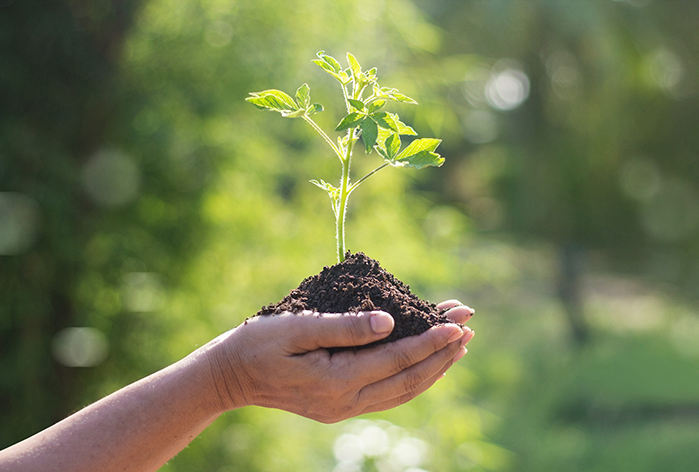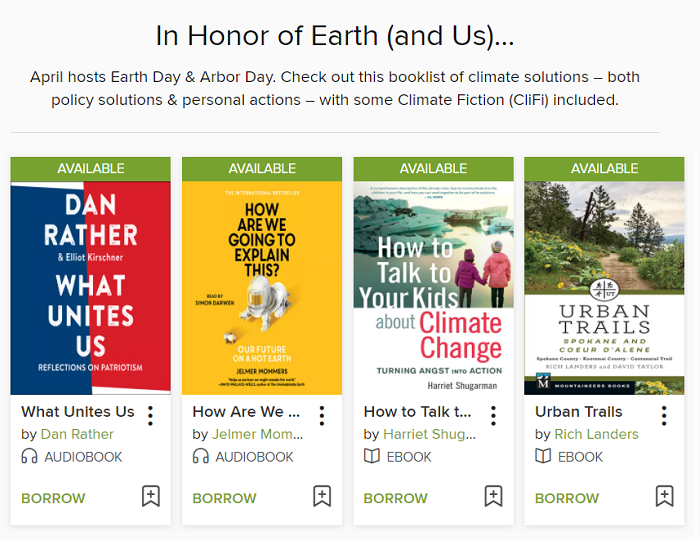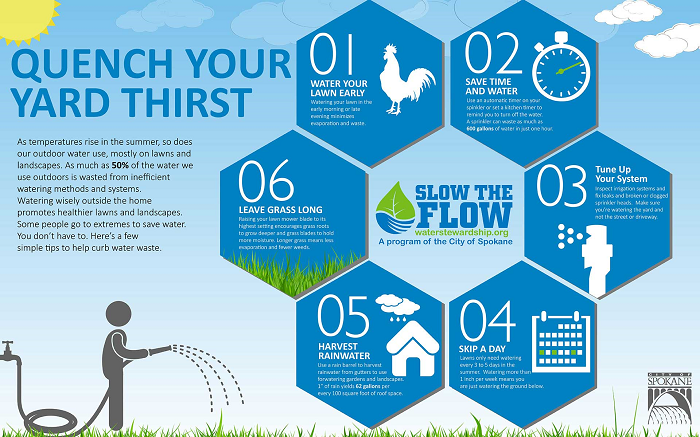Celebrating Earth this month with activities, library programs & an action plan
Posted on April 5, 2021 at 6:45 am
BY CRYSTAL MILLER

OUR WATER USAGE
April brings Earth Day celebrations and gardening fun. When many of us are busy planning our garden layout, possibly filled with colorful flowers or vibrant veggies, we may not be considering how much water each of the plants require.
Did you know that according to data from the U.S. Geological Survey, Spokane County uses three times more water than the national average?
A recent article from KXLY explores how Spokane County is near the top of the list for water consumption in the U.S. and shares this eye-opening statistic: “One person usually uses around 79 gallons of water a day, but the average use for a single person in Spokane County is around 235 gallons.”
Adam Shank, from the Spokesman-Review, wrote the article “City leaders agree Spokane needs to use less water. But how can they convince residents and businesses?” He reports that the City’s Water Resource Collaboration Group outlined a plan to cut water use by 25%, but even if this water reduction goal is achieved, “Spokanites already use so much water that the plan would still leave the city in the 96th percentile nationally, based on 2015 United States Geological Survey data.”
In the article, the city’s manager of sustainable initiatives Kara Odegard says, “We’ve been under the impression that we have unlimited water supply, and with a changing climate and our growing community that is no longer really the case.” Odegard believes that reducing water consumption by 25% in Spokane is “both ambitious and achievable.”
CIVIC LAB ONLINE & OVERDRIVE READING
To learn more about water consumption, gardening, and additional actions you can take to improve your green thumbprint, I encourage you to check out the library’s most recent Civic Lab Online: Water Conservation & Gardening. You’ll find resources to read, listen to, and watch—all on this very topic. You’ll even find instructions to create a DIY rain barrel that you can use to collect water for use in your yard.
For a robust booklist of eBooks and audiobooks on the topic, look no further than the latest OverDrive booklist In Honor of Earth (and Us)…, which is packed with titles that share climate solutions and even some climate fiction.

GARDENING & NATURE PROGRAMS & EVENTS
If you have gardening questions, you can ask Master Gardener Kurt Madison tomorrow during Gardening Through the Seasons: Spring Emphasis at 6pm (April 6). Registration for this program closes today (April 5) at 5pm, so be sure to sign up as soon as you can.
You can also take part in fun outdoor activity for the whole family to celebrate Earth Day! Check out the program Earth Day BioBlitz with iNaturalist. This program has two parts: an adventure in a park and an online meet-up.
To participate, you find and identify as many plants and animals as possible, during the week of April 15–22, using the iNaturalist app in any of the following parks: Mirabeau Point Park in Spokane Valley, Sutton Park in Cheney, and Library Park in Deer Park. The whole family can get in on the fun using a mobile device to record the birds in the sky, the insects by your feet, and the plants and trees all around!
After a week of collecting this information in the three community parks, we will meet online to showcase what everyone has found on Saturday, April 24, at 11am. Students and faculty from the Eastern Washington University Biology department will answer questions about the local plants and wildlife. Be sure to register for the meet-up, so you can get the login instructions and see all of the cool critters and plants.
NATIVE PLANTS & XERISCAPES
Using native plants and/or transitioning to xeriscapes are ways that are gaining popularity for reducing water usage.
Xeriscaping is the practice of designing landscapes to reduce or eliminate the need for irrigation. You can read about the process of creating a xeriscape yard and see before and after images from fellow blogger Jane in her post Drought-tolerant yard project: Researching, planning, digging & planting.

The Spokane County Master Gardeners, through the WSU Extension department, have a web page with lists of native and drought tolerant plants specific to our area that are adapted to thrive without the addition of a large quantity of extra watering. If you’re ready to ditch your lawnmower and move to a xeriscape yard, they also have online xeriscape resources to get you started.
If you’re not ready to part with your green grass, WSU Extensions’ publications program provides some tips on saving water in these two free, downloadable publications: Saving Water: Lawns and Other Turf and Drought Advisory: Water Conservation in Gardens and Landscapes.
The Spokane Conservation District also provides a variety of examples and plans for water efficient landscape design. Seeing the before and after pictures of specific projects can be very inspiring!
The City of Spokane has a Water Wise Spokane resource page, and Spokane County has some great tips for outdoor water conservation. The Slow the Flow “Quench Your Yard Thirst” poster shares six steps for conserving water and is a handy reminder that can be printed and placed on the fridge or near a gardening workbench.

POLLINATOR GARDENS & OTHER RESOURCES
As the gardening planning commences, there are ways to garden to help combat climate change. The National Wildlife Federation provides tips in its article Gardening for Climate Change to help you get started.
You may be considering growing a pollinator garden. According to Hill’s Honey Bee Co-Op in Spokane, “Pollinator gardens are not only gorgeous, they also support pollinators by supplying them with food, in the form of pollen and nectar. Planting a pollinator garden will ensure that these important animals stay in the area and continue pollinating our crops.”
LOCAL & NATIONAL GROUPS
The world’s first Earth Day took place in 1970. Since then more than 1 billion individuals have mobilized for the future of the planet and over 75,000 partners are working to drive positive change.
You can find ways to get involved at the Earth Day website and find resources and 2021 Earth Day events taking place as well.
If you’re looking to get involved in a local group focused on preserving nature in our region, here are a few organizations to check out:
I wish you a happy spring. And I hope you’ve found some useful resources to make your garden as water efficient as possible and some fun opportunities to celebrate Earth Day!
Crystal Miller is a Business and Career Development Librarian and has been working in libraries for 15 years. She has a master’s in library science from Simmons College and has worked at the Harvard Development Office Library, MIT Libraries, and the Coeur d’Alene Public Library. When she’s not at the library, she can be found at the dog park with her three fur babies or with a cookbook in hand, flipping through the pages, looking for the next recipe to try out.
Tags: BioBlitz, gardening, library programs, Master Gardeners, water conservation

